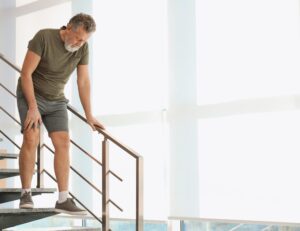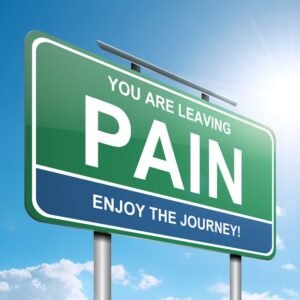 Initially, you notice a bit of stiffness in the mornings, but it resolves quickly. Long walks are the only activity that bothers your knee. Over time, pain is triggered by increasingly ordinary activities such as walking downstairs or standing up from a chair. The knee takes longer to loosen up in the mornings, and you’ve had to reduce your walking distance due to pain. You’re even noticing pain at rest and when sleeping and you may notice swelling after exercise. The knee feels like it might buckle when going upstairs or getting out of a car.
Initially, you notice a bit of stiffness in the mornings, but it resolves quickly. Long walks are the only activity that bothers your knee. Over time, pain is triggered by increasingly ordinary activities such as walking downstairs or standing up from a chair. The knee takes longer to loosen up in the mornings, and you’ve had to reduce your walking distance due to pain. You’re even noticing pain at rest and when sleeping and you may notice swelling after exercise. The knee feels like it might buckle when going upstairs or getting out of a car.
Do any of these symptoms sound familiar? Osteoarthritis (OA) is the most common type of arthritis and affects more Canadians than all other forms of arthritis combined. OA is a disease of our joints and most commonly affects the joints of the hands, feet, hips, knees and spine. Can the condition worsen over time? Yes, but its rate of progress varies between different people. Is an osteoarthritic joint always painful? No. It is entirely possible to have OA and be pain-free. Its effect on people varies greatly. Some people with very “mild” OA on X-rays can experience pain to a greater degree than some people with “severe” findings. There is no simple correlation between a person’s x-ray findings and their symptoms and level of disability.
 Osteoarthritis was once thought to be caused by the wear and tear associated with aging. It is now understood that it is a result of the body’s failed attempt to repair joint tissues damaged due to abnormal loading, joint injury and/or obesity (1).
Osteoarthritis was once thought to be caused by the wear and tear associated with aging. It is now understood that it is a result of the body’s failed attempt to repair joint tissues damaged due to abnormal loading, joint injury and/or obesity (1).
Some common misconceptions surrounding knee osteoarthritis include:
- It is caused by impact exercises like long distance running.
- It will only get worse over time and will require surgical intervention.
- Knee pain while exercising will lead to further joint damage.
- Rest is the best treatment for OA.
If you have been diagnosed with osteoarthritis or have some of the symptoms detailed above, what are the next steps?
Your physiotherapist can diagnose knee osteoarthritis through a clinical exam. In certain cases, diagnostic imaging may be helpful. However, x-ray results can sometimes negatively influence how we perceive our injuries. Imagine if you had an x-ray and were told that you have severe osteoarthritis and “bone on bone” changes. Exercise may seem scary now. But as mentioned, there appears to be little correlation between X-ray findings and one’s level of pain and disability.
Osteoarthritis is caused by a multitude of factors. And what contributes to a person’s symptoms is multifactorial and equally complex. For example, obesity increases one’s risk of OA by 163% and previous knee trauma by 286%. Other risk factors include one’s occupation, age, and lower extremity alignment. Regardless, the common theme among these contributing factors appear to be from alterations in loading across the joint.
 What we do know is that moderate repetitive loading of the cartilage in our joints is necessary to maintain healthy joint cartilage (2). So, for our lower extremities, an intermediate level of physical activity (minimum of 45 minutes/week of moderate intensity in increments of at least 10 minutes) reduces pain and improves function in individuals with lower extremity OA (3). However, the amount and type of activity that is optimal needs to be personalized to each individual. This is where physiotherapy can help.
What we do know is that moderate repetitive loading of the cartilage in our joints is necessary to maintain healthy joint cartilage (2). So, for our lower extremities, an intermediate level of physical activity (minimum of 45 minutes/week of moderate intensity in increments of at least 10 minutes) reduces pain and improves function in individuals with lower extremity OA (3). However, the amount and type of activity that is optimal needs to be personalized to each individual. This is where physiotherapy can help.
What type of activity is best for OA? Aerobic exercise, resistance training, and Tai Chi appear to all provide similar health related benefits. In addition, land-based exercise appears equally as effective as water-based exercise in managing osteoarthritis (3). To summarize, engaging in some type of exercise on a weekly basis is key!
If your ability to exercise is limited by pain, a physiotherapist can help. We will work with you to modify your activities and we can provide you with pain management tools. While it is true that some people may need injections or joint replacements, conservative management should always be tried and exhausted first. So, don’t struggle alone. Call us today for advice and a personalized program!
References:
1. Public Health Agency of Canada (PHAC). (2010). Life with Arthritis in Canada: a personal and public health challenge [PDF]. Ottawa, ON: PHAC. Retrieved from www.canada.ca/content/dam/phac-aspc/migration/phac-aspc/cd-mc/arthritis-arthrite/lwaic-vaaac-10/pdf/arthritis-2010-eng.pdf
2. Griffin et al (2005). The Role of Mechanical Loading in the onset and progression of Osteoarthritis. Exer Sport Sci Rev. 33(4), 195-200.
3. Kraus, V. B., Sprow, K., Powell, K. E., Buchner, D., Bloodgood, B., Piercy, K., George, S. M., Kraus, W. E., & 2018 Physical Activity Guidelines Advisory Committee (2019). Effects of Physical Activity in Knee and Hip Osteoarthritis: A Systematic Umbrella Review. Medicine and science in sports and exercise, 51(6), 1324–1339. https://doi.org/10.1249/MSS.0000000000001944

